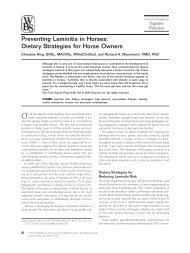Nutritional Secondary Hyperparathyroidism in the Horse
Nutritional Secondary Hyperparathyroidism in the Horse
Nutritional Secondary Hyperparathyroidism in the Horse
You also want an ePaper? Increase the reach of your titles
YUMPU automatically turns print PDFs into web optimized ePapers that Google loves.
Etiology 35<br />
Experiments and cl<strong>in</strong>ical studies s<strong>in</strong>ce INGLE’S report have<br />
supported him fully. The optimum calcium to phosphorus ratio <strong>in</strong> <strong>the</strong><br />
feed is now considered to be 1 : 1 [Natl. Acad. Sci. (1961)l. KINTNER<br />
and HOLT (1932) <strong>in</strong> feed<strong>in</strong>g trials us<strong>in</strong>g affected horses found that<br />
excessive bone resorption was arrested when <strong>the</strong> ratio was 1.17 : 1 or<br />
above and that excessive resorption progressed when <strong>the</strong> ratio was<br />
decreased to 1 : 1.41 or below.<br />
The absolute amounts of calcium and ratios used <strong>in</strong> <strong>the</strong> experimental<br />
reproduction of <strong>the</strong> disease are summarized <strong>in</strong> Table VIII.<br />
In above reports as well as <strong>in</strong> that by KINTNER and HOLT, <strong>the</strong><br />
ratios of calcium oxide and phosphorus pentoxide were given. The<br />
values given <strong>in</strong> <strong>the</strong> above list refer to calcium and phosphorus, <strong>in</strong>stead.<br />
The normal requirement for <strong>the</strong> horse [Natl. Acad. Sci. (1961)l is<br />
given <strong>in</strong> Table IX.<br />
3. Occurrence and Breed, Sex, and Age Predsposition<br />
<strong>Nutritional</strong> secondary hyperparathyroidism <strong>in</strong> <strong>the</strong> horse has been<br />
described, under vary<strong>in</strong>g terms, from countries all over <strong>the</strong> world<br />
accord<strong>in</strong>g to <strong>the</strong> review by KINTNER and HOLT (1932). Mbcs~ (1959),<br />
however, referred to <strong>the</strong> disease as an “extra-European’’ osteodystrophy,<br />
which is surpris<strong>in</strong>g because <strong>the</strong> disease was first described <strong>in</strong><br />
Switzerland [RYCHNER (1851)l and because <strong>the</strong> nature of <strong>the</strong> bone<br />
lesions was first revealed, as we have seen, <strong>in</strong> Germany [JOST (1910)l.<br />
The <strong>in</strong>cidence varies considerable. Sporadic cases as well as<br />
“enzootic” outbreaks have been reported. STURGESS and CRAWFORD<br />
(1927) stated that at least 10% of all horses <strong>in</strong> Ceylon were affected to<br />
some degree. KINTNER and HOLT (1932) reported that about 15% of<br />
<strong>the</strong> U. S. Army horses on native feed <strong>in</strong> <strong>the</strong> Philipp<strong>in</strong>es were affected <strong>in</strong><br />
1930-1931. In <strong>the</strong> first six months of 1931 no less than 285 cases were<br />
diagnosed. The disease accounted for more than one-fourth of all<br />
hospitalized horses. YAMAGIWA and SATOH (1956) reported 499 cases<br />
from 1951 to 1956 at <strong>the</strong>ir pathology department <strong>in</strong> Japan, which<br />
certa<strong>in</strong>ly <strong>in</strong>dicates a very high <strong>in</strong>cidence.<br />
No breed predisposition has been reported, and sex is not a<br />
predispos<strong>in</strong>g factor ei<strong>the</strong>r. In accordance with <strong>the</strong> fact that <strong>the</strong> calcium<br />
requirement is higher dur<strong>in</strong>g pregnancy [Natl. Acad. Sci. (1961)],<br />
KINTNER and HOLT (1932) showed that all <strong>in</strong>vestigators had agreed<br />
“that pregnancy may <strong>in</strong>fluence <strong>the</strong> development and/or <strong>the</strong> course of<br />
Downloaded from<br />
vet.sagepub.com by guest on April 14, 2010



